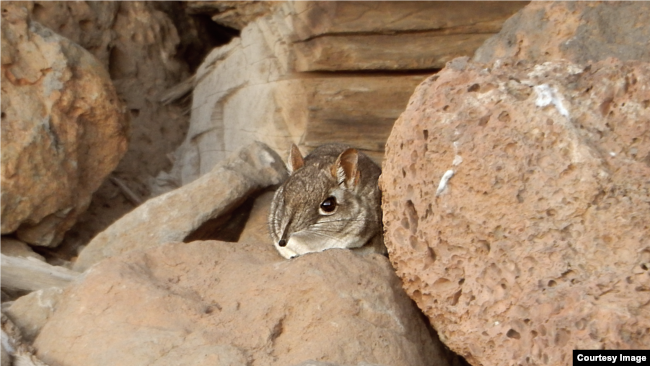Scientists say they have rediscovered in Africa a small creature related to the elephant that disappeared about 50 years ago.
The mouse-sized animal, called the Somali sengi, is also known as an elephant-shrew. It is distantly related to elephants, aardvarks and manatees.
Researchers say sightings of the Somali sengi species had not been reported for at least 50 years.
But a search team led last year by international wildlife experts found that the animals were alive and well in the small East African country of Djibouti. The team recently reported its results in the publication PeerJ.
Although the species was only known to live in Somalia, the researchers had received information that it might also be in Djibouti.

Djibouti fieldwork, in search of the Somali Sengi. (Photo by Galen Rathbun, California Academy of Sciences)
Scientists thought the Somali sengi had disappeared in the 1970s. There are only 39 individual specimens held in natural history museums around the world. Those individuals were the only physical evidence that the animal had ever existed.
The Global Wildlife Conservation group had included the Somali sengi on its "25 most wanted lost species" list.
Houssein Rayaleh is with the Association Djibouti Nature. He helped lead the search operation. In Djibouti, he said they met local people who were able to identify the animal from pictures.
Rayaleh said he too had seen sengis during his 21 years of doing fieldwork in the country. But he and other researchers could never make an official identification. "Without formal documentation, the species of the sengis in Djibouti was unknown," he told the French news agency AFP.
The team set up more than 1,250 traps filled with peanut butter, oatmeal and yeast in 12 places. The researchers reported they caught a Somali sengi in the first trap they set.
“It was amazing,” said Steven Heritage, a researcher with Duke University’s Lemur Center in Durham, North Carolina. “When we opened the first trap and saw the little tuft of hair on the tip of its tail, we just looked at one another and couldn’t believe it.”

This photo represents the northern-most documentation of the Somali Sengi. This occurrence locality expands the known range of the species considerably. (PHoto by Houssein Rayaleh, Association Djibouti Nature)
Heritage noted that a number of small mammal searches since the 1970s had failed to find the Somali sengi in Djibouti. “It was serendipitous that it happened so quickly for us,” he said.
For Rayaleh, the find was not all that surprising. “For us living in Djibouti, and by extension the Horn of Africa, we never considered the sengis to be ‘lost,’” he said. “But this new research does bring the Somali sengi back into the scientific community, which we value.”
The team also included global elephant shrew expert Galen Rathburn, who had studied the creatures for many years. But Heritage said Rathburn had never before seen a live Somali sengi.
"So when he opened the first trap and looked over at me, and he had seen the cute tufted furry tail of the animal, he looked at me and said 'I can't believe it, I've never seen one before,’” Heritage told AFP. Rathburn died of cancer shortly after the trip.

Djibouti fieldwork, in search of the Somali Sengi. (Photo by Galen Rathbun, California Academy of Sciences)
The researchers collected 12 specimens of the animal. They said their study proves that the Somali sengi "is currently extant" and lives far beyond the boundaries of Somalia.
The team is planning a new search to learn more about the species, which it believes could be living across Somalia, Djibouti and Ethiopia.
The researchers are not able to estimate the size of the population, but they believe the animals are doing well. "All the local people knew about this, so it could not be rare in any way," Heritage said.
Finding a large, living population differs greatly from most organized rescue attempts involving endangered species, said Robin Moore of Global Wildlife Conservation. "Usually when we rediscover lost species, we find just one or two individuals," she said.
Words in This Story
species – n. a group of animals or plants that are similar and can reproduce
specimen – n. an animal or plant that is collected as an example of its kind
museum – n. a building in which interesting and valuable things (such as paintings and sculptures or scientific or historical objects) are collected and shown to the public
formal – adj. done officially in keeping with rules
amazing – adj. causing great surprise or wonder
tuft – n. a small group of hair or similar thing that grows closely together
mammal – n. an animal with fur that feeds its young milk
serendipitous – n. the luck that happens when a useful or good thing is found without looking for it
global – adj. of, relating to, or involving the entire world
extant – adj. in existence, still alive